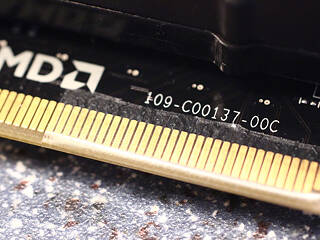 73
73
AMD Radeon HD 5870 PCI-Express Scaling Review
Test Setup »Introduction
September 2009 is a big month for both AMD and Intel in nearly equal measures. While Intel introduced its brand new socket LGA-1156 family of processors and the Intel P55 chipset to drive its platform, AMD launched the industry's first DirectX 11 compliant lineup of graphics processors, particularly the Radeon HD 5870 (our review here), which is powered by the fastest graphics processor currently available. To ensure that the graphics card is working to its full-potential, one of the important factors is the system interface, and the system's ability to provide as much bandwidth as it can to the GPU. One of the characteristic features of Intel's socket LGA-1156 processors is the on-die PCI-Express 2.0 switch that can provide a PCI-Express 2.0 x16 link for graphics.
Thanks to the modular, scalable design of PCI-Express, consisting of independent data-paths called 'lanes', motherboard designers can control a limited PCI-Express lane budget, and offer multiple PCI-Express x16 slots. In mid-range motherboards, and particularly in most motherboards based on Intel's newest P55 chipset, 16 PCI-Express lanes are used to drive two PCI-Express slots with bandwidths of 8 lanes each. These two slots can then accommodate two graphics cards for multi-GPU performance upscaling using ATI CrossfireX or NVIDIA SLI technologies. It should also be noted that PCI-Express 2.0 doubles the bandwidth available per lane. So if you read about PCI-E x8 2.0 in this review, these results are representative of a PCI-E x16 link in 1.1 mode - like on many old motherboard. Another important point to make is that PCI-Express is forward and backwards compatible. You can run any PCI-E 1.x card in a 2.0 slot or any 2.0 card in any 1.x slot, with reduced bandwidth of course.
In this review, we test the impact of running the ATI Radeon HD 5870 graphics accelerator on PCI-Express slots that are electrically PCI-Express 2.0 x8, x4, and x1. This is done by covering the data-paths using thin, insulating adhesive tape, which turns off those data-paths (lanes), while still keeping the device functional. Tests at PCI-Express 2.0 x8 will show you how the Radeon HD 5870 with its seemingly heavy system bandwidth requirement fares on systems with PCI-Express 2.0 x16 electrical x8 slots. Tests at PCI-Express 2.0 x4 will give you a rough idea of how it fares on systems with PCI-Express x16 electrical x4 (there are plenty of such motherboards), and also systems with PCI-Express 1.1 x16 electrical 1.1 x8. Finally, we dared to run this monstrosity on just one PCI-Express 2.0 lane. Not only was it functional, but also stable, returning results on all the tests we threw at it. While not serving any practical purpose, tests on PCI-Express x1 are merely of academic relevance.
Jul 31st, 2025 07:49 CDT
change timezone
Latest GPU Drivers
New Forum Posts
- I just bought an RX570 4Gb (10)
- What local LLM-s you use? (217)
- Gigabyte graphic cards - TIM gel SLIPPAGE problem (174)
- XFX RX580 code 43 error (8)
- What are you playing? (24028)
- What's your latest tech purchase? (24412)
- AI Job Losses: let's count the losses up, total losses to AI so far 94,000 and counting (92)
- Your PC ATM (35569)
- Does a bigger case actually run quieter if you’re using the same number of fans? (28)
- Question Realtek wifi usb chips (0)
Popular Reviews
- MSI Claw 8 AI+ A2VM Review
- Lenovo Legion 5i (15IRX10) Review - Feature-Rich and Wallet Friendly
- Herman Miller Logitech G Embody Review - No Pain, No Gain
- Orbital Pathfinder Review
- Lian Li O11 Dynamic Mini V2 Review
- Upcoming Hardware Launches 2025 (Updated May 2025)
- Noctua NF-A12x25 G2 PWM Fan Review
- Sapphire Radeon RX 9060 XT Pulse OC 16 GB Review - An Excellent Choice
- AMD Ryzen 7 9800X3D Review - The Best Gaming Processor
- NVIDIA GeForce RTX 5050 8 GB Review
TPU on YouTube
Controversial News Posts
- AMD's Upcoming UDNA / RDNA 5 GPU Could Feature 96 CUs and 384-bit Memory Bus (137)
- AMD Radeon RX 9070 XT Gains 9% Performance at 1440p with Latest Driver, Beats RTX 5070 Ti (131)
- Intel "Nova Lake-S" Core Ultra 3, Ultra 5, Ultra 7, and Ultra 9 Core Configurations Surface (110)
- DDR6 Memory Arrives in 2027 with 8,800-17,600 MT/s Speeds (102)
- AMD Sampling Next-Gen Ryzen Desktop "Medusa Ridge," Sees Incremental IPC Upgrade, New cIOD (97)
- Intel CEO Confirms SMT To Return to Future CPUs (95)
- NVIDIA Becomes First Company Ever to Hit $4 Trillion Market-Cap (94)
- Windows 12 Delayed as Microsoft Prepares Windows 11 25H2 Update (93)

